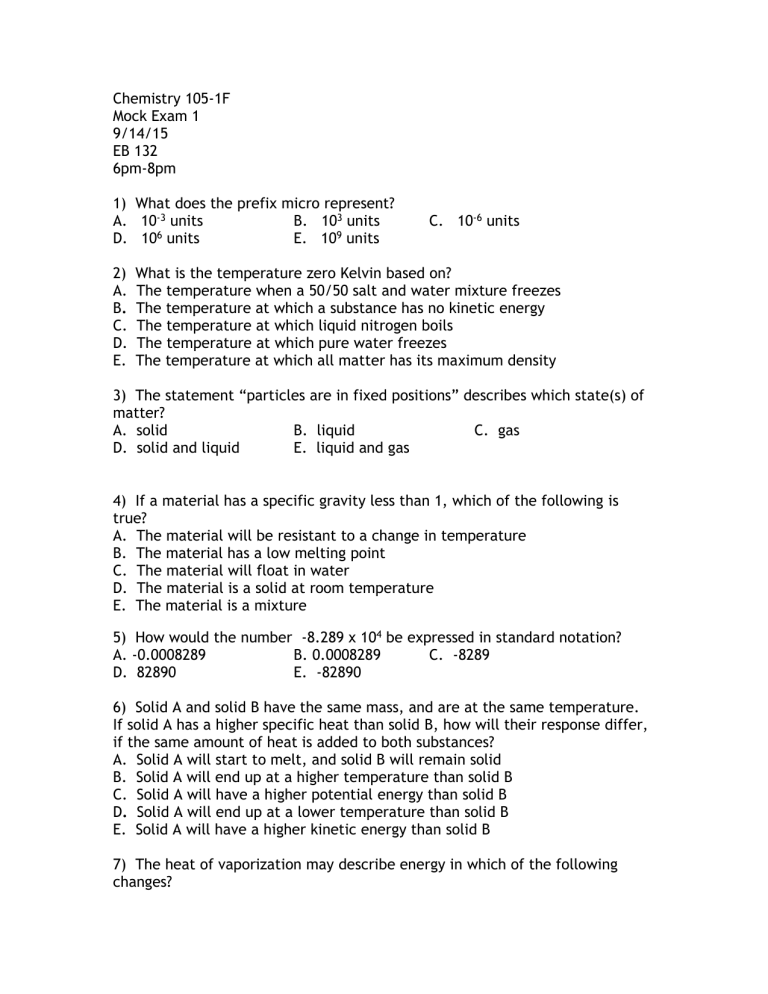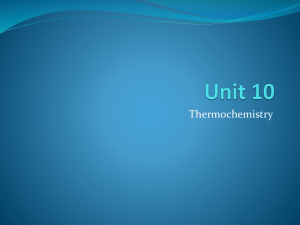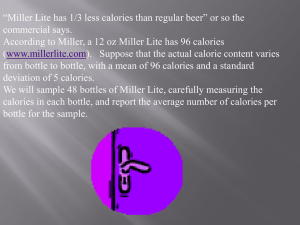Chemistry 105-1F Mock Exam 1 9/14/15 EB 132 6pm

Chemistry 105-1F
Mock Exam 1
9/14/15
EB 132
6pm-8pm
1) What does the prefix micro represent?
A. 10 -3 units B. 10 3 units
E. 10 9 units
C. 10 -6 units
D. 10 6 units
2) What is the temperature zero Kelvin based on?
A. The temperature when a 50/50 salt and water mixture freezes
B. The temperature at which a substance has no kinetic energy
C. The temperature at which liquid nitrogen boils
D. The temperature at which pure water freezes
E. The temperature at which all matter has its maximum density
3) The statement “particles are in fixed positions” describes which state(s) of matter?
A. solid
D. solid and liquid
B. liquid
E. liquid and gas
C. gas
4) If a material has a specific gravity less than 1, which of the following is true?
A. The material will be resistant to a change in temperature
B. The material has a low melting point
C. The material will float in water
D. The material is a solid at room temperature
E. The material is a mixture
5) How would the number -8.289 x 10 4
A. -0.0008289
D. 82890
be expressed in standard notation?
B. 0.0008289 C. -8289
E. -82890
6) Solid A and solid B have the same mass, and are at the same temperature.
If solid A has a higher specific heat than solid B, how will their response differ, if the same amount of heat is added to both substances?
A. Solid A will start to melt, and solid B will remain solid
B. Solid A will end up at a higher temperature than solid B
C. Solid A will have a higher potential energy than solid B
D. Solid A will end up at a lower temperature than solid B
E. Solid A will have a higher kinetic energy than solid B
7) The heat of vaporization may describe energy in which of the following changes?
A. freezing
D. deposition
B. condensation
E. melting
C. sublimation
8) Which of the following is a characteristic of all matter?
A. Can be broken into simpler substances
B. Has potential energy
C. Made up of more than one element
D. Has a volume
E. Cannot be divided into smaller particles
9) Which of the following measurements would be expressed using a derived unit?
B. mass C. time D. length E. A. specific heat energy
10) Which of the following phrases best describes an exothermic change?
A. potential energy is absorbed
B. kinetic energy is absorbed
C. potential energy is given off
D. kinetic energy is given off
E. there is no change in energy
11) You are going to go skydiving this weekend, and wonder how much time you will be in the air. If you jump from the plane at an altitude of 11850 feet and fall at an average of 120 miles per hour, approximately how long would you be in the air? (Assuming a parachute failure, so you don’t slow down! And given that 1 mile = 5280 feet)
A. 1 minute C. 4 minutes B. 2 minutes
E. 8 minutes D. 6 minutes
Gallium thermodynamic data: melting point = 29.76°C boiling point = 2204°C specific heat of solid gallium = 0.089 cal / g * °C
density of solid gallium = 6.12 g/mL heat of fusion = 19.2 cal / g
heat of vaporization = 871 cal / g
specific heat of liquid gallium = 0.56 cal / g * °C
12) Approximately how much energy is given off by a 52-gram sample of gallium as it cools from 117 °C to 84 °C?
C. 960 calories A. 150 calories
D. 2450 calories
B. 540 calories
E. 3060 calories
13) What is the melting point of gallium, when expressed in degrees
Fahrenheit?
A. 34 °F B. 86 °F C. 91 °F D. 111 °F E. 303 °F
Xylene thermodynamic data: melting point = 25 o C boiling point = 80 o C heat of fusion = 120 cal / g
heat of vaprization = 360 cal / g
specific heat of soli xylene = 0.25 cal / g * °C specific heat of liquid xylene = 0.30 cal / g * °C
/ g * °C specific heat of xylene gas = 0.20 cal
14) How much heat is given off when 40.0 grams of xylene has its temperature cooled from 79 o C to 35ºC?
A. 352 calories B. 45 calories C. 245 calories D. 120 calories E. 266 calories
15) Using the information above for xylene, how much heat would be required to raise a 5 gram sample from 65ºC to 85ºC?
A. 1260 calories B. 13045 calories C. 1828 calories D. 1000 calories E.
1625 calories
16) 230 calories are added to 92 g of liquid nitrogen and the temperature increases from -247 o C to -182 o C, without a phase change. What is the specific heat of liquid nitrogen?
A. 0.0385 cal/gºC B. 0.385 cal/gºC C. 0.0245 cal/gºC
D. 1.456 cal/gºC E. 0.0123 cal/gºC
17) How many inches are in 456 millimeters? (Hint: convert to cm first)
A. 20in B. 18in C. 17in D. 45in E. 12in
18) If I travel 452 miles on 20.5 gallons of gas, what is the fuel economy in
Kilometers per gallon? (1mi = 1.6093Km)
A.33
Km
/ g
B. 69
Km
/ g
C. 29
Km
/ g
D. 35
Km
/ g
E. 43
Km
/ g
19) An object has a mass of 201 grams, and a density of 1.65 g/mL. What is the volume of this object, in milliliters?
A. 122 mL B. 135 mL C.119 mL D.205 mL E.110 mL
Please answer the following question honestly and be prepared to share your feedback at the end of the session.
20) Do you feel comfortable speaking out (in class or sessions) if you do not understand a topic?
21) How can CH 105-1F SI sessions be improved? Think in terms of structure and function.
22) Do you feel like you benefit from the worksheets provided? If not, offer a new idea or way of explaining material.
23) Would you like to have a session on Wednesday after your exam, or would you like to wait for the following Monday when there is more material to cover?








